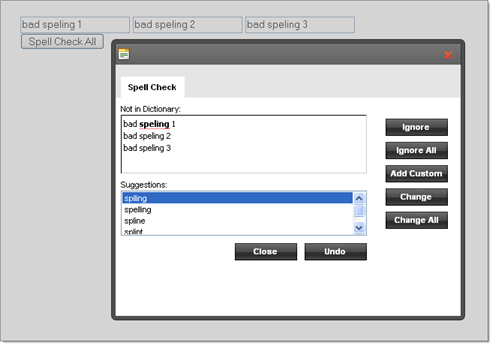Spellchecking Multiple Text Areas
Scenario
How to spell-check multiple text-areas at once using a custom text source.
Solution
To spell check multiple text sources:
-
Define a Custom Text Source that accepts a single "sources" parameter. The parameter will accept an array of element text that will be passed to it.
-
In the get_text() method for the custom text source, get the text from each control and join these strings with separators to make a single string.
-
In the set_text() method parse the "text" property and use the parts to populate the "sources" array.
-
Create an array of HtmlElementTextSource that in turn takes the contents of each textbox in the constructor.
-
Create an instance of your new custom text source object, passing the array of HtmlElementTextSource in the constructor.
-
Call the RadSpell client object set_textSource() method, passing the new custom text source object instance.
HtmlElementTextSource is defined in the Telerik.Web.UI.Spell assembly, and registered for availability to JavaScript within RadSpell.js. RadSpell.js is normally a resource and not visible to you, but you can find the JavaScript source in the Telerik® UI for ASP.NET AJAX installation directory under "\scripts".
This general approach can be used not just for TextBoxes, but for spell checking any combination of controls on a web page.
At runtime the joined string might look like: "bad spelling 1
<controlSeparator><br/></controlSeparator>bad spelling 2<controlSeparator><br/></controlSeparator>bad spelling 3" But is displayed as in Figure 1 . The "<controlSeparator>" tags are arbitrary and can be any unique string that is used to join in the get_text() method and parse back apart in the set_text() method. The "<br>tags are necessary to show each misspelling on a separate line in the "Not in Dictionary' section of the dialog.
Figure 1: Errors shown from multiple text areas without the
</controlSeparator>keyword

<telerik:RadCodeBlock ID="RadCodeBlock1" runat="server">
<script type="text/javascript">
function MultipleTextSource(sources)
{
this.sources = sources;
this.get_text = function()
{
var texts = [];
for (var i = 0; i < this.sources.length; i++)
{
texts[texts.length] = this.sources[i].get_text();
}
return texts.join("<controlSeparator><br/></controlSeparator>");
}
this.set_text = function(text)
{
var texts = text.split("<controlSeparator><br/></controlSeparator>");
for (var i = 0; i < this.sources.length; i++)
{
this.sources[i].set_text(texts[i]);
}
}
}
function spellCheck()
{
var sources =
[
new Telerik.Web.UI.Spell.HtmlElementTextSource($get('TextBox1')),
new Telerik.Web.UI.Spell.HtmlElementTextSource($get('TextBox2')),
new Telerik.Web.UI.Spell.HtmlElementTextSource($get('TextBox3'))
];
var spell = $find('<%= RadSpell1.ClientID %>');
spell.set_textSource(new MultipleTextSource(sources));
spell.startSpellCheck();
}
</script>
</telerik:RadCodeBlock> <asp:ScriptManager ID="Scriptmanager1" runat="server">
</asp:ScriptManager>
<asp:TextBox ID="TextBox1" runat="server"></asp:TextBox>
<asp:TextBox ID="TextBox2" runat="server"></asp:TextBox>
<asp:TextBox ID="TextBox3" runat="server"></asp:TextBox>
<telerik:RadSpell RenderMode="Lightweight" ID="RadSpell1" runat="server" ButtonType="None" />
<input id="Button1" type="button" value="Spell Check All" onclick="spellCheck();" />